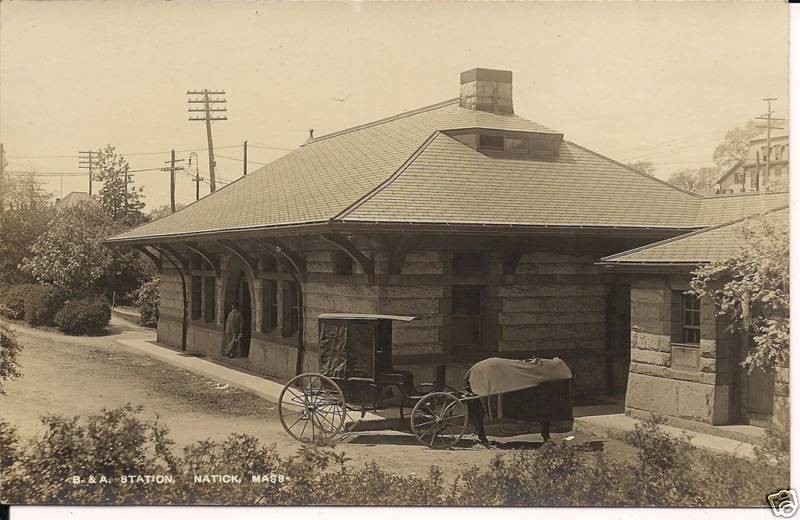
The old Natick Center train station is invisible after it was “buried’ in 1962, but it’s still there, behind the platform mural.
The “underground” Natick Center Train Station
Nearly 130 years ago, a new passenger train station was built in Natick Center. Its platform and canopy are still there. The original station building is still there—but it’s invisible. All commuters now see an asphalt and concrete platform with a functional canopy. What remains of that Romanesque-style passenger station is now the basement of Dion’s South Avenue liquor store. Some paneled walls, the waiting room, and the bathroom of the old granite/brownstone structure are still recognizable. The street-level building that houses Anton’s Cleaners and Dion’s was built over the roof of the track-side station in the early 1960s.
* * *
About 190 years ago, the railroad was an essential catalyst for the growth of Natick. The old Boston and Worcester Railroad (chartered June 23, 1831) first laid tracks at street level through Natick beginning in August 1834. The arrival of the “iron horse” was an economic boon for the town. This transformative transportation technology boosted Natick’s growth and importance in the expanding commerce of eastern Massachusetts when Natick’s entrepreneurial shoe industry was in its early growth phase. In the 1830s, the Natick-to-Boston rail passenger fare in summer months was 75 cents. The original single track stretching from Boston to Framingham became a double track five years later. A branch line from Natick to the Saxonville section of Framingham became operational in 1846. By 1870, the B&W, with three other railroads, merged to become the Boston and Albany Railroad, and later, the trackage was owned by Penn Central until the MBTA acquired the rail line from Framingham to Boston in 1973.
Within ten years after the station was built, increasing traffic demands led to constructing a third, and then a fourth, set of tracks through downtown Natick. By the mid-20th century, cars and trucks were taking more and more passenger and freight business from the rails. Rail service was reduced to two tracks through Natick in 1962, and the railroad company divested the town center station. The sloped roof of the station was removed, and the station itself was enclosed within a street-level building now occupied by Anton’s and Dion’s. The station's side and back walls were buried and became the new structure's foundation.
The rail line extension in the 1830s contributed to the impending failure of the for-profit east-west turnpike enterprise that had been big news 30 years earlier. The Boston and Worcester Turnpike (incorporated in 1806) had stimulated commerce and development along its length, passing through Natick on the route of what is now Rt. 9. By 1835, the turnpike corporation was struggling financially. The turnpike owners opposed the original rail route closely paralleling their turnpike, and so the track in Natick was laid two miles to the south (its present location). Passenger and commercial traffic quickly shifted to more efficient railroad transportation, and the turnpike owners surrendered their charter on September 1, 1841, making Worcester Road (Rt. 9) a free county highway.
Natick historian Oliver Bacon wrote of the turnpike’s economic demise:
“The old Turnpike is a pike no more,
Wide open stands the gate.
We have made us a road for our horse to stride,
Which we ride at a flying rate.”
The West Natick commuter rail station opened on August 23, 1982. Most non-express inbound and outbound trains stop at both stations.
On January 12, 2015, responding to the town’s request, the MBTA officially changed the name of the station to Natick Center.
Natick’s first passenger rail station was built in the mid-19th century at street level at the corner of South Avenue (Railroad Avenue) and Washington Street. An eminent domain procedure took the land owned by the Harwood & Sons baseball company for the station.
Later, the modest structure was moved closer to Main Street. Two other stations (no longer existing) were located at Lake Crossing (at Pond Road on the border with Wellesley to the east) and Walkerville (at Speen Street to the west). The tracks in the center of town were at street level through the early 1890s, when population growth and increasing rail and street traffic created more frequent congestion and concerns about safety.
Image: Natick train station, photograph, date unknown. Source: Unknown
In 1894, the town decided to lower about a half mile of the rail bed up to 30 feet below street level in the town center to eliminate grade crossings (bridges were built on Main Street and Marion Street to handle pedestrian and vehicle traffic). Work was completed in the fall of 1897.
In that year, a new railroad station was built between Main Street and Washington Street (the current station is on the same spot), and the old mid-century station was removed. The imposing new 1897 station was built by Shepley, Rutan & Coolidge, Boston architects who installed most of the stations of that period on the Boston and Albany lines. Constructed of granite and brownstone, the station stood at the trackside with a sloped pathway that led down from South Avenue. The rear of the station was accessible to horse-drawn wagons and carriages and, later, to motorized vehicles.
Image: The original 1850s Natick station building, date unknown. Source: Unknown
The 1897 station was designed by Alexander Wadsworth Longfellow Jr. in the Richardson Romanesque style. It had heavy walls and curved arches that matched those of other stations on the B&A line. The station also had a sloping roof and a canopied waiting platform.
Image: Natick Station, postcard, 1897. Source: Unknown
The 1897 station had distinctive rough-hewn granite walls with decorative stone embellishments.
Image: Natick station rear entrance for passenger access at the upper level, postcard, 1897. Source: Unknown
The north station wall facing the tracks was concealed behind a cement block facade covered by the splendid mural that’s visible today.
Image: Natick Train Station mural, date unknown. Source: Unknown
The old 1897 station is now the basement of the liquor store, where a bay window in the north wall that may have served as a passenger ticket window is still visible. The original canopy on the inbound track platform is still in use. The current station is not accessible for handicapped passengers—commuters use stairs to get down to the platform.
Image: Dion’s Liquor Store basement, date unknown. Source: Unknown
return to 19th-century menu:
click here
Selected sources and additional reading:
Natick Historical Society collections.
Natick Center Cultural District. “Natick Center History.” Accessed June 19, 2019. https://www.natickcenter.org/natick-center-history






